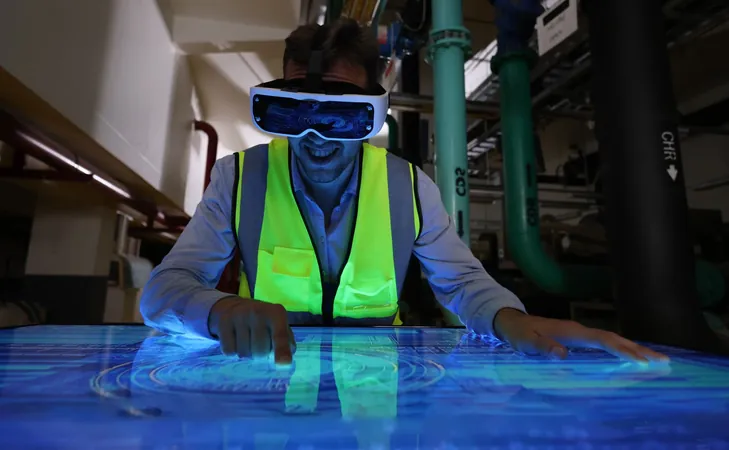
Revolutionary Breakthrough: Cells Shed Mitochondria, Unveiling Their Secrets!
2025-07-03
Author: Wei Ling
DALLAS – July 3, 2025
A groundbreaking study from UT Southwestern Medical Center has revealed tantalizing insights into the mysterious world of mitochondria, the powerhouse of our cells. Using a cutting-edge genetic technique to force cells to eliminate their mitochondria, researchers have opened new doors for understanding these vital organelles and may pave the way for innovative treatments for mitochondrial disorders such as Leigh syndrome and Kearns-Sayre syndrome.
"This new tool enables us to explore how variations in mitochondrial quantity and genetics affect cellular function and evolution," remarked Dr. Jun Wu, the study's co-leader and Associate Professor of Molecular Biology.
The Mysterious Origins and Functions of Mitochondria
Mitochondria, found in the cells of most eukaryotic organisms—like animals, plants, and fungi—are unique in that they possess their own genetic material, inherited solely from mothers. These organelles are believed to have originated from ancient prokaryotic cells, establishing a symbiotic relationship with ancestral eukaryotic cells.
Beyond just energy generation, mitochondria influence essential cellular processes such as cell death, stem cell differentiation, and even aging. However, the intricate relationship between mitochondria and nuclear DNA, especially the consequences of disruptions in communication, had remained largely enigmatic until now.
Enforced Mitophagy: Unleashing Cellular Secrets
To delve deeper into these mysteries, Dr. Wu and his team employed a process called enforced mitophagy, enabling cells to actively discard their mitochondria. By using this technique on human pluripotent stem cells (hPSCs), they made a striking discover: even without mitochondria, the cells survived in culture for up to five days!
While the changes halted cell division, researchers found that the mitochondria-depleted cells could still partially compensate for their energy needs, showcasing the adaptability and resilience of cellular machinery.
Cross-Species Insights: What Can We Learn About Mitochondria?
To investigate how differences in mitochondrial DNA could alter cellular behavior, the researchers fused human hPSCs with stem cells from our closest primate relatives, including chimpanzees and gorillas. This led to the creation of composite cells, allowing them to definitively identify how the absence of non-human primate mitochondria affected overall gene expression.
Interestingly, the variations in gene activity linked to human versus non-human primate mitochondria predominantly centered around brain development and neurological diseases. This opens a new avenue of exploration into what makes human brains unique and could have huge implications for understanding neurodevelopmental disorders.
The Bigger Picture: Implications for Development and Evolution
Moving beyond isolated cells, the researchers experimented with enforcing mitophagy in mouse embryos. While those missing over 65% of mitochondria failed to implant successfully, embryos lacking a third managed to adapt, aligning back to normal mitochondrial levels within days.
These findings could serve as a launchpad for future studies exploring the diverse roles mitochondria play in not just cells, but in tissue and organ development, aging, and even the evolutionary paths of species.
What’s Next?
The team, including several prominent researchers at UT Southwestern, is set to dive deeper using enforced mitophagy as a tool to unravel the multifaceted functions of mitochondria across biological disciplines.
This research not only sheds light on cellular processes but also tightly knits the fabric of evolution, potentially transforming how we understand human health and disease. Stay tuned for what this scientific exploration might unveil next!





 Brasil (PT)
Brasil (PT)
 Canada (EN)
Canada (EN)
 Chile (ES)
Chile (ES)
 Česko (CS)
Česko (CS)
 대한민국 (KO)
대한민국 (KO)
 España (ES)
España (ES)
 France (FR)
France (FR)
 Hong Kong (EN)
Hong Kong (EN)
 Italia (IT)
Italia (IT)
 日本 (JA)
日本 (JA)
 Magyarország (HU)
Magyarország (HU)
 Norge (NO)
Norge (NO)
 Polska (PL)
Polska (PL)
 Schweiz (DE)
Schweiz (DE)
 Singapore (EN)
Singapore (EN)
 Sverige (SV)
Sverige (SV)
 Suomi (FI)
Suomi (FI)
 Türkiye (TR)
Türkiye (TR)
 الإمارات العربية المتحدة (AR)
الإمارات العربية المتحدة (AR)